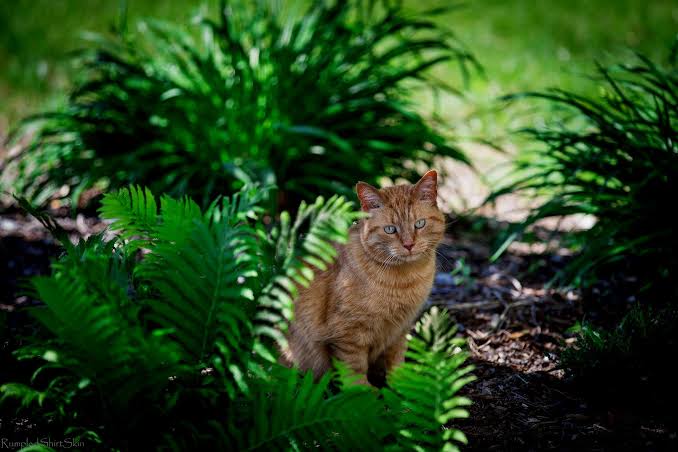Are ferns toxic to cats? This is a common question among pet owners considering adding ferns to their indoor plant collection. Understanding the potential toxicity of ferns is crucial for ensuring the safety and well-being of cats in households where these plants are present.
In this article, we will explore the toxicity of ferns to cats, including which fern species are toxic and which are safe. We’ll also discuss the symptoms of fern poisoning in cats and provide tips on how to prevent potential exposure. By the end of this article, you’ll have a better understanding of the risks associated with ferns and how to keep your feline friends safe around these plants.
Recommended article: Are Monstera Toxic to Cats?
What Are Ferns?

Ferns are a diverse group of plants known for their feathery leaves, which are called fronds, and their ability to thrive in moist, shady environments. Ferns reproduce by spores instead of seeds, which sets them apart from other plants. There are thousands of species of ferns, ranging from small, delicate varieties to large, tree-like ferns.
Types of Ferns
1. Boston Fern (Nephrolepis exaltata)
- Description: The Boston fern is a popular houseplant known for its lush, arching fronds and air-purifying qualities.
- Care: It thrives in bright, indirect light and moist soil. Regular watering and occasional misting are beneficial for its growth.
2. Maidenhair Fern (Adiantum spp.)
- Description: Maidenhair ferns are characterized by their delicate, fan-shaped fronds and wiry black stems.
- Care: They prefer high humidity and indirect light. Consistent moisture is essential, but they should not be overwatered.
3. Bird’s Nest Fern (Asplenium nidus)
- Description: Bird’s nest ferns have broad, wavy fronds that resemble a bird’s nest, giving them a unique appearance.
- Care: They thrive in low to medium light and require well-draining soil.
4. Staghorn Fern (Platycerium spp.)
- Description: Staghorn ferns are epiphytic, meaning they grow on other plants or trees. They have two types of fronds: shield fronds that anchor them to their host and fertile fronds that resemble antlers.
- Care: They require bright, indirect light and good air circulation. They can be watered by misting or soaking their root ball.
5. Japanese Painted Fern (Athyrium niponicum)
- Description: Japanese painted ferns are prized for their colorful foliage, which features shades of silver, green, and burgundy.
- Care: They prefer partial to full shade and moist, well-draining soil. They are relatively low-maintenance once established.
Recommended article: Are Pothos Toxic to Cats?
Are Ferns Toxic to Cats?

While many ferns are safe for cats and non-toxic, some species can be harmful if ingested. It’s crucial to research specific fern species to ensure they are safe for your feline friends. If you have any concerns about the toxicity of ferns or if your cat has ingested a fern and is showing symptoms of poisoning, consult with your veterinarian immediately.
Toxicity of Ferns to Cats
Ferns are popular houseplants known for their lush foliage and elegant appearance. While many ferns are safe for cats, some species can be toxic if ingested. It’s essential to be aware of the potential risks to ensure the safety of your feline companions.
Fern Species Toxic to Cats
- Asparagus Fern (Asparagus densiflorus): This fern is toxic to cats and can cause symptoms such as vomiting, diarrhea, and abdominal pain if ingested.
- Maidenhair Ferns (Adiantum spp.): Certain types of maidenhair ferns are also considered toxic to cats and can lead to gastrointestinal issues if consumed.
Potential Risks for Cats
- Gastrointestinal Upset: Ingesting toxic ferns can lead to gastrointestinal upset in cats, including symptoms like vomiting and diarrhea.
- Dehydration: Severe cases of fern poisoning can lead to dehydration in cats, which can be a serious health concern.
Recommended article: Are Money Trees Toxic to Cats?
Non-Toxic Ferns for Cats
While some fern species can be toxic to cats, there are several non-toxic varieties that are safe to have around feline companions. Here are some non-toxic ferns that are considered safe for cats:
1. Boston Fern (Nephrolepis exaltata)
- Characteristics: Boston ferns are known for their feathery, arching fronds that can grow up to 3 feet long. They thrive in humid environments and are relatively easy to care for.
- Suitability: Boston ferns are safe for cats and can be a beautiful addition to your home decor. Their non-toxic nature makes them a popular choice for pet owners.
2. Maidenhair Fern (Adiantum spp.)
- Characteristics: Maidenhair ferns are known for their delicate, lacy foliage and elegant appearance. They require high humidity and indirect light to thrive.
- Suitability: Certain species of maidenhair ferns are toxic to cats but some, such as Adiantum raddianum, are non-toxic to cats and can be a lovely addition to your indoor garden.
3. Bird’s Nest Fern (Asplenium nidus)
- Characteristics: Bird’s nest ferns have wide, glossy fronds that resemble a bird’s nest. They are relatively low-maintenance and can tolerate lower light conditions.
- Suitability: Bird’s nest ferns are safe for cats and can add a tropical touch to your home while providing a safe environment for your feline friends.
4. Rabbit’s Foot Fern (Davallia spp.)
- Characteristics: Rabbit’s foot ferns are named for their furry rhizomes that resemble rabbit’s feet. They prefer bright, indirect light and consistent moisture.
- Suitability: Rabbit’s foot ferns are non-toxic to cats and can be an interesting addition to your indoor plant collection.
5. Australian Sword Fern (Nephrolepis obliterata)
- Characteristics: Australian sword ferns have long, narrow fronds with a slightly arching growth habit. They are drought-tolerant and can thrive in various light conditions.
- Suitability: Australian sword ferns are safe for cats and can be a versatile choice for both indoor and outdoor settings.
When choosing ferns for your home with cats, always ensure that the specific species you select is non-toxic. By adding these non-toxic ferns to your indoor garden, you can create a safe and enriching environment for both your plants and your feline companions.
Recommended article: Is Bamboo Toxic to Cats?
Frequently Asked Questions About Ferns and Cats
1. Are All Ferns Toxic to Cats?
- No, not all ferns are toxic to cats. While some fern species, such as the asparagus fern and certain types of maidenhair ferns, are toxic to cats if ingested, many other common fern species are considered safe.
2. What Are the Symptoms of Fern Poisoning in Cats?
- Symptoms of fern poisoning in cats can include vomiting, diarrhea, drooling, oral irritation, lethargy, weakness, loss of appetite, and in severe cases, neurological symptoms like tremors or seizures.
3. How Can I Tell If My Cat Has Ingested a Toxic Fern?
- If you suspect your cat has ingested a toxic fern, look out for symptoms such as vomiting, diarrhea, drooling, and behavioral changes. It’s crucial that you contact your Vet immediately.
4. What Should I Do If My Cat Eats a Toxic Fern?
- If you believe your cat has ingested a toxic fern, contact your veterinarian immediately. They can provide guidance on the next steps, which may include inducing vomiting or administering supportive care.
5. How Can I Prevent Fern Poisoning in Cats?
- To prevent fern poisoning in cats, keep toxic ferns out of reach or consider replacing them with non-toxic alternatives. Supervise your cat when they are around plants and use deterrents if necessary.
Recommended article: Can Cats Eat Cherries?
Conclusion: Ensuring a Safe Environment for Your Feline Companion
In conclusion, while some fern species can be toxic to cats if ingested, many common ferns are considered safe. It’s essential for pet owners to be aware of the potential risks associated with toxic ferns and take preventive measures to protect their feline companions.
By familiarizing yourself with the symptoms of fern poisoning in cats and seeking veterinary care promptly if you suspect ingestion of a toxic plant, you can help ensure your cat’s safety and well-being. Additionally, implementing preventive measures such as placing toxic ferns out of reach, using deterrents, and providing non-toxic alternatives can further reduce the risk of fern poisoning.
Remember, each cat is unique, and their tolerance to different plants may vary. It’s always best to err on the side of caution and consult with your veterinarian if you have any concerns about the safety of specific fern species for your cat.
For more information on pet safety, health, and care, be sure to check out our website. We’re dedicated to providing valuable resources to help you keep your furry friends happy and healthy.

